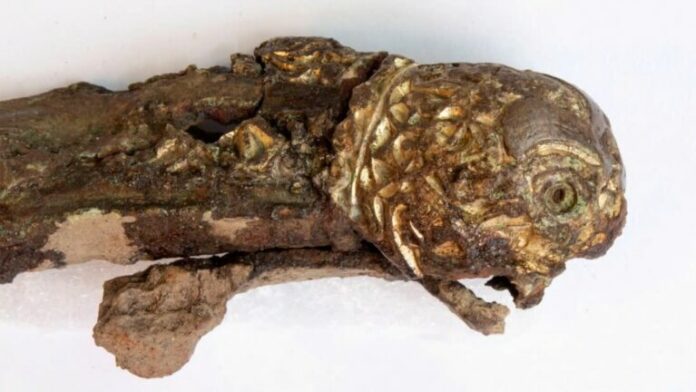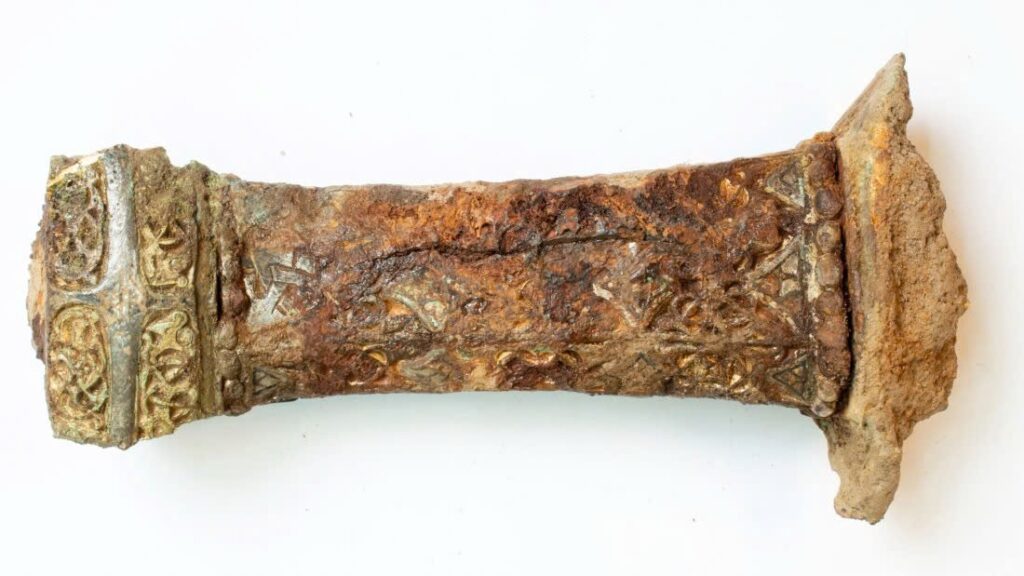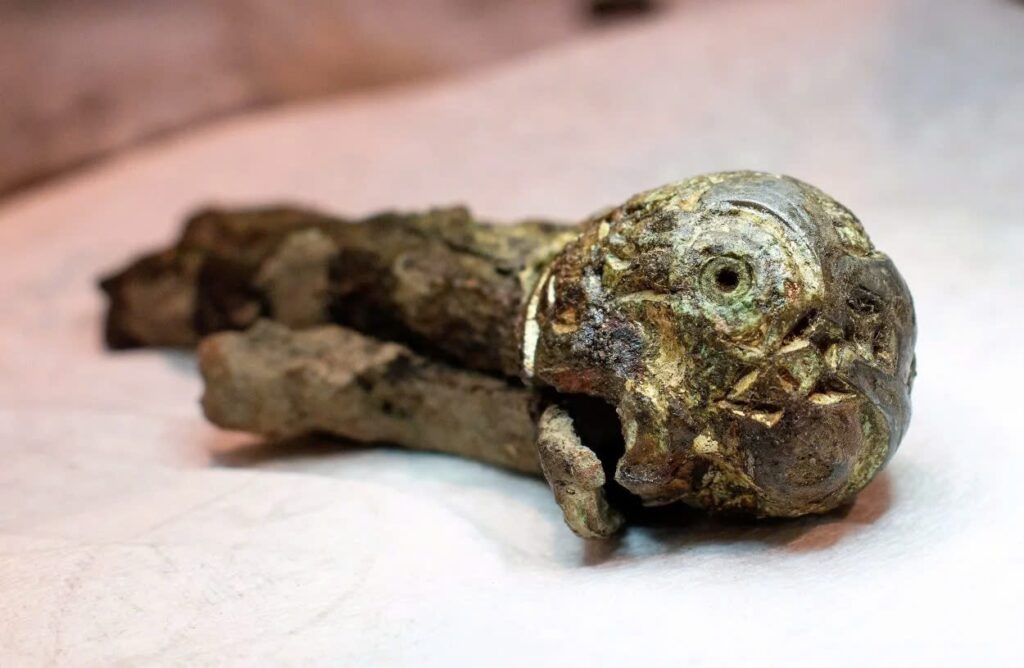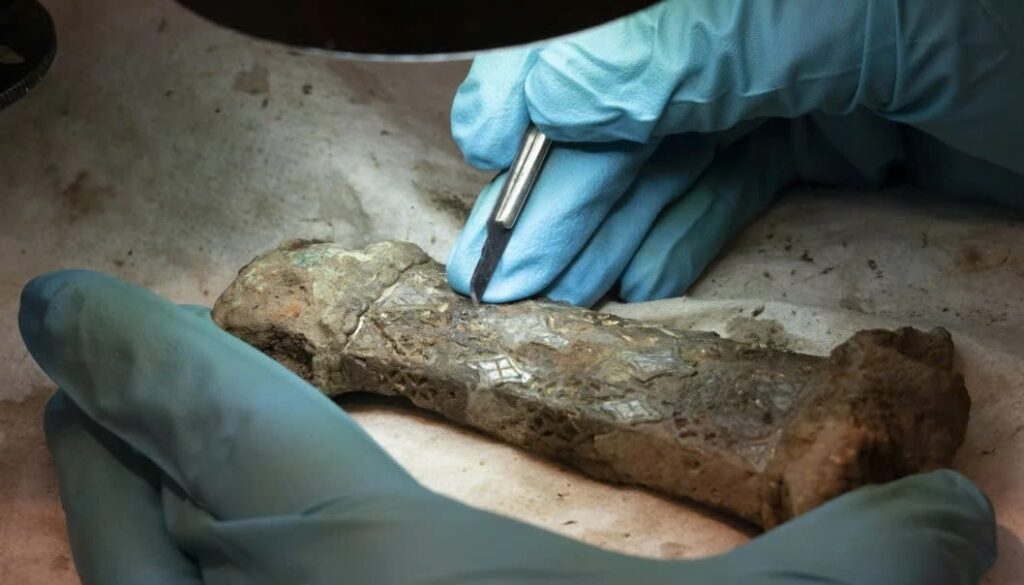Unearthed in Norway: The Stunning Viking Sword That Defied Time

In the peaceful fields of Gausel, Stavanger, along Norway’s western coast, an extraordinary chapter of Viking history has recently been uncovered. What started as two separate discoveries by metal detector enthusiasts has culminated in the revelation of one of the most ornate and substantial swords from the Viking Age. This unique find not only sheds light on Viking craftsmanship but also tells a fascinating story of serendipity and historical significance.
A Serendipitous Discovery

The remarkable journey began last year when a metal detectorist stumbled upon a small, irregular piece of metal on a farm in Gausel. Unaware of its true significance, the finder handed it over to the Stavanger Archaeological Museum. Little did they know that this seemingly insignificant fragment was part of a much larger, historic artifact.
In an intriguing twist of fate, a friend of the original finder returned to the same field a year later. This time, they unearthed a large section of a beautifully decorated sword hilt. Upon bringing it to the museum, conservators were astonished to discover that the two pieces fit together perfectly, revealing them to be parts of the same ancient weapon.
The Magnificent D-Sword

The sword belongs to an elite category known as the D-sword, celebrated for its intricate design and considerable weight. Despite the discovery of over 3,000 Viking swords throughout history, only 20 D-swords have been found in Norway, making this discovery exceptionally rare and significant.
A Window into Viking Craftsmanship

Exquisite Ornamentation
The sword hilt’s elaborate decoration is a testament to the exceptional skill of Viking-era artisans. It features gilded elements that depict animal motifs typical of the Iron and Viking Ages, alongside geometric patterns in silver created using the niello technique. The ends of the crossguard are shaped like animal heads, adding a distinctive and unique character to the weapon.
International Connections
The ornamentation on the sword suggests that it may have originated in the Frankish Empire or England. Its closest known counterpart is a sword discovered on the Scottish island of Eigg, which dates back to the 9th century. This international connection highlights the extensive trade and cultural exchanges that occurred during the Viking Age.
Preserving Viking Legacy

As archaeologist Zanette Glørstad from the University of Stavanger’s Museum of Archaeology explains, “The technique is of very high quality, and both the lavish and complicated decor and the special formation of the crossguard make this a truly unique find.” Currently, the sword hilt is undergoing meticulous cleaning and conservation. Soon, it will be placed on permanent display at the museum, offering visitors a rare glimpse into the rich tapestry of Viking history and craftsmanship.
Conclusion
The discovery of this magnificent Viking sword in Gausel is a remarkable tale of chance and historical preservation. From two separate fragments to a complete, ornate weapon, this sword serves as a testament to the craftsmanship and cultural connections of the Viking Age. As it takes its place in the museum, this unique piece will continue to inspire and educate, offering a tangible link to the past and the enduring legacy of the Vikings.
Video
News
The Hanging Temple: China’s 1,500-Year-Old Cliffside Marvel of Faith and Engineering
The Hanging Temple: China’s 1,500-Year-Old Cliffside Marvel of Faith and Engineering Perched precariously on the cliffs of Mount Heng in Shanxi Province, China, the Hanging Temple, also known as Xuankong Temple, Hengshan Hanging Temple, or Hanging Monastery, is an architectural…
The Willendorf Venus: A 30,000-Year-Old Masterpiece Reveals Astonishing Secrets
The Willendorf Venus: A 30,000-Year-Old Masterpiece Reveals Astonishing Secrets The “Willendorf Venus” stands as one of the most revered archaeological treasures from the Upper Paleolithic era. Discovered in 1908 by scientist Johann Veran near Willendorf, Austria, this small yet profound…
Unveiling the Maya: Hallucinogens and Rituals Beneath the Yucatán Ball Courts
Unveiling the Maya: Hallucinogens and Rituals Beneath the Yucatán Ball Courts New archaeological research has uncovered intriguing insights into the ritual practices of the ancient Maya civilization. The focus of this study is a ceremonial offering found beneath the sediment…
Uncovering the Oldest Agricultural Machine: The Threshing Sledge’s Neolithic Origins
Uncovering the Oldest Agricultural Machine: The Threshing Sledge’s Neolithic Origins The history of agricultural innovation is a fascinating journey that spans thousands of years, and one of the earliest known agricultural machines is the threshing sledge. Recently, a groundbreaking study…
Nara’s Ancient Sword: A 1,600-Year-Old Protector Against Evil Spirits
Nara’s Ancient Sword: A 1,600-Year-Old Protector Against Evil Spirits In a remarkable discovery that has captured the attention of archaeologists and historians alike, a 7.5-foot-long iron sword was unearthed from a 1,600-year-old burial mound in Nara, Japan. This oversized weapon,…
The Inflatable Plane, Dropped Behind the Lines for Downed Pilots
Experimental The Inflatable Plane, Dropped Behind the Lines for Downed Pilots The Inflatoplane from Goodyear was an unconventional aircraft developed by the Goodyear Aircraft Company, a branch of the renowned Goodyear Tire and Rubber Company, also famed for the Goodyear…
End of content
No more pages to load











